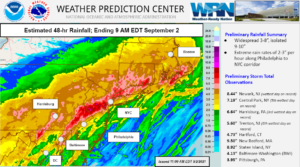If producers have concerns about flooded pastures and forage quality; or concerns about heavy metal contamination in flood contaminated water and soils that can lead to livestock toxicities, here is an article for Progressive Forage I wrote on this topic this spring that may be useful. See the article, Adverse Weather Impacts Essential Nutrient Uptake.

Weather Prediction Center estimated rainfall totals from Ida as of September 2 2021
In areas impacted by the debris field of tornadic and straight-line winds; and receding flood waters, metal objects and other splintered particles are of concern. Producers (volunteers, workers, families) should review their tetanus vaccinations for themselves and their livestock and be mindful of metal and other small particle debris contamination of any additional forage harvest this season.
Any superficial cuts should be disinfected promptly and monitored for signs of bacterial infection. This is important to remind, as many are wearing rubber boots these days as opposed to hard soled leather boots. Any puncture of any kind should be seen by a doctor if it occurred from an object previously submerged in flood waters.
Additional information about past storm mortalities associated with toxic bacteria, poisonous plants, and plant-pest toxins can be found in the Northeastern Plant Pest Conference abstract, Recent Extreme Weather Events: Animal Deaths Linked to Toxic Plant and Pest Outbreaks.
For local information on the storm rainfall estimates from Ida, follow this link: https://www.wpc.ncep.noaa.gov/discussions/nfdscc4.html.
